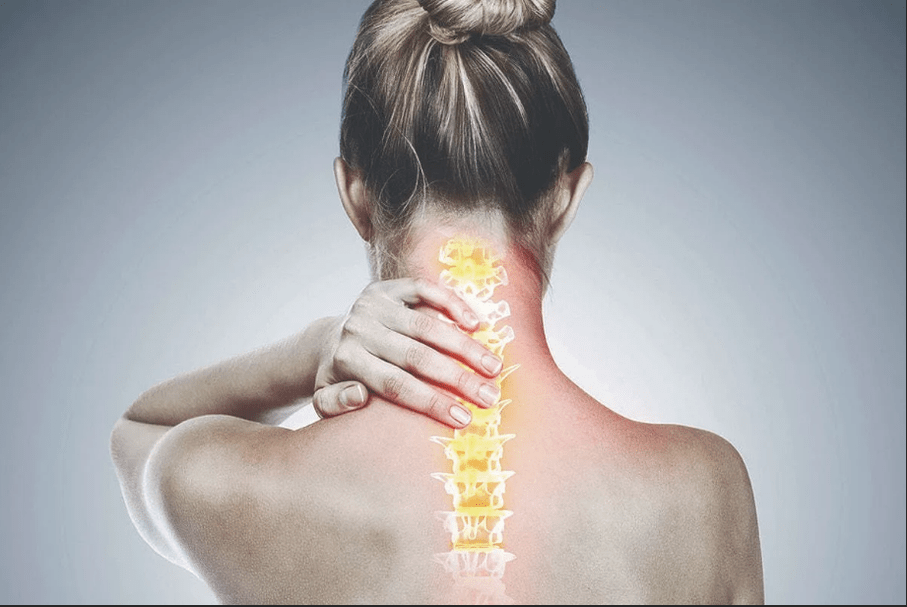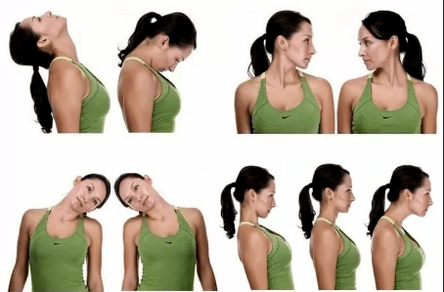Cervical osteochondrosis is a dystrophic lesion and a progressive deigenerative of the intervertebral disc in the area of 1-7 vertebrae belonging to the cervical region.

As a result of cervical osteochondrosis, deformation, fatigue, and then damage the vertebral body.This disrupts the normal supply of blood and the conductivity of the nerves in the neck and in areas isolated by the cervical nerve root.
Cervical osteochondrosis can be isolated or combined with other parts of osteochondrosis - chest, lumbar and sacred.
Cause
Causes of dystrophic and degenerative changes in the intervertebral disc has not yet been studied.The assumption that osteochondrosis is a phenomenon of indecent verification.It is found even in children and adolescents.
A number of predisposing factors to the development of osteochondrosis are distinguished.These include:
- Sedomers and inactive lifestyles,
- Sitting type of work with static load on the neck,
- overweight, inadequate physical development,
- The process of displaced connective tissue,
- a violation of blood circulation in the neck,
- neck injury,
- Scoliosis, posture defects, pillows and uncomfortable mattresses,
- Descent predisposing, metabolic defects.
Symptoms of cervical osteochondrosis
The cervical spine, due to the features of the frame, hatred, and due to the large size of the head, is highly exposed to the development of osteochondrosis-vertebrae in it is the smallest compared to other parts of the spine, and the muscle frame is not very pronounced.
The most characteristic symptoms that the patient complains about - pain in the cervical region.Depending on the damage zone, the pain may be localized
- in the collar and shoulders;
- along the cervical spine;
- On the front surface of the chest.
Pain for cervical osteochondrosis is caused by the characteristics of the cervical area.
The first signs of cervical osteochondrosis are not important and slightly specific:
- Pain in the neck in the evening,
- Head weight, headache in the occipital zone,
- feeling numb or tingling on the shoulders and hands,
- Christ around the neck when turning on the head, clicking the vertebra.
Leading symptoms:
Vegetative-dystonic
- Severe pain in the neck and, especially, in the area below the back of the head;
- Pain occurs after a long stay in one position (for example, after sleep);
- Neck muscles are always tense;
- There is difficulty with neglect of hand to the side;
- On the affected side, the fingers are constrained in movement.
Because the vertebral artery is compressed, neurological manifestations are observed: headache, nausea, fainting.
The symptoms of the spine
The pain is located behind the sternum on the left.
This type of pain should be distinguished from pain in the angina pectoris (with angina pectoris, nitroglycerin relieved, with osteochondrosis - no).
With the gradual violation of the intervertebral disc structure, their compression (compression) occurs and nerve root violations occur, as well as narrowing or infringement of the arteries and veins, which occur in the vertebral body area.
This leads to the formation of special syndrome - radicular and ischemia.
- Defeat of the first cervical vertebra root (C1): infringement affects the back of the head, reducing skin sensitivity;
- Lesion C2 gives pain in the crown and back of the head;
- Wound C3 Provides pain in the neck from the side of the violation, decreases in the tongue and sub -languages, in some cases with speech disorders and loss of control over the language;
- Defeats C4 and C5 provide pain in the shoulders and clavics, decreased head and neck muscle tone, hiccup, respiratory disorders and liver pain;
- The most frequent C6 defeat, giving pain from the neck to the shoulder, lower arm, until the thumb, skin sensitivity can suffer:
- The defeat of the C7 gives the same symptoms with pain in the neck, back of the shoulder, to the back of the hand, breaking the strength of the hand and the decrease in reflex.
Disorders of blood circulation due to compression of the vessels in the cervical vertebra area provide headaches up to migraines, severe dizziness, visual and ear disorders, flashing flies in front of the eyes, disruption of autonomic function.
There may be manifestations of cardiac syndrome with compression heart disease, lack of air and heartbeat, rhythm disorders.
Complication
The serious complications of cervical osteochondrosis are
- the highlight of the intervertebral disc with the formation of hernia (protrusion);
- Rupture of intervertebral discs with nerve and blood vessels, spinal cord compression, which can lead to death;
- There are also radiculopathies (root injury), the formation of osteophytes (spikes on the vertebra) with manifestations of paresis and paralysis.
Diagnostics

In the presence of the above complaints, an appeal to an orthopedic doctor or neurologist is necessary.
First of all, doctors will evaluate mobility and pain in the neck, sensitivity and other functions.Then, cervical spinal radiography in several projections is required, if necessary, computed tomography or magnetic resonance scan with hernia suspicion.
In the event of blood circulation disorders, rheoencephalography and fundus examination are required.
Treatment of cervical osteochondrosis
The same symptoms can be a sign of various diseases, and the disease may not occur according to the textbook.Don't try to treat yourself - consult your doctor.
Today, there are traditional and non -traditional methods for the treatment of osteochondrosis in the cervical spine.
Conservative methods are used primarily:
- Symptom therapy with analgesic (Baralgin, Analgin) to relieve pain syndrome
- Taking anti -non -series series (Diclofenac, Indomethacin, Meloxicam) -To relieve inflammation and edema
- To get rid of muscle cramps, antispasmodic is used -no -shpu, medicine to improve blood circulation -trental.
In the treatment of cervical osteochondrosis, the material that restores the intervertebral disc structure is used - Theflex.
Group B Vitamin Therapy Course is shown, external products for therapy can be used - gels and ointments, creams with anti -anticipated components, heating and analgesics - Voltaren.Intervertebral disc regeneration stimulation is shown - teraflex or chondroxide.
In the treatment of cervical osteochondrosis, wearing a special collar (Shantsa Collar) is recommended.
Cervical osteochondrosis complications between vertebral hernia that violate sensitivity and blood circulation can be treated immediately.
The duration of treatment depends on the neglect of the condition, as osteochondrosis is a progressive chronic disease.Treatment can be long, and preventive courses are performed for life.
Proper nutrition will help relieve osteochondrosis.Read more about the principle of diet for osteochondrosis in our separate articles.
Training for the treatment of cervical osteochondrosis:

- The attractiveness itself: in a position with a straight back, it is necessary to lower the shoulder as low as possible, while the neck must be pulled.It should take at least 10 approaches at least 3 times a day.
- Self: Grace the neck with a towel, take it with the ends and pull it for them alternately, spreading the neck muscles.In this case, it is necessary to ensure that the towel does not slide around the neck.
- Gymnastics for the cervical region for osteochondrosis: Small bending of the neck, as well as turns and head tilt, are shown.At one time, 5-7 tendencies were made in each direction.This exercise is most useful to do after yourself from the cervical spine.
Prevention
The cervical spine health basis is a strong and healthy physical activity, a comfortable bed with anatomical pillows and mattresses, proper posture and proper nutrition.
Need to prevent neck injury and weight loss.It is necessary to incorporate prolonged sitting with a rest and warm time.


























